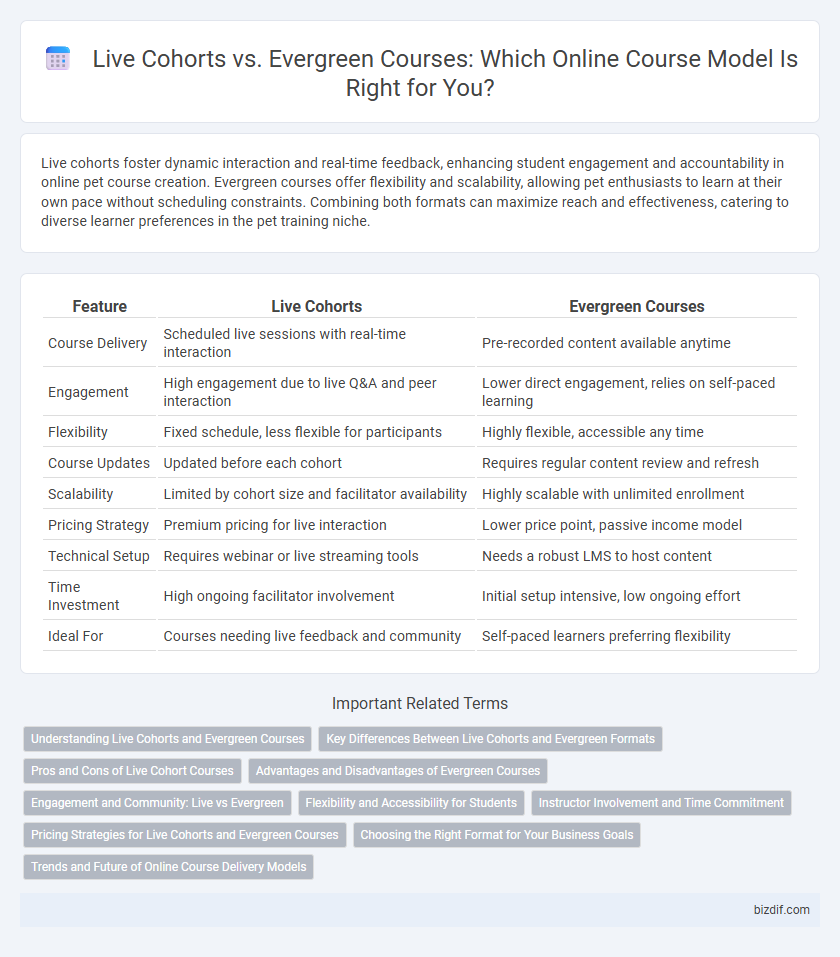Live cohorts foster dynamic interaction and real-time feedback, enhancing student engagement and accountability in online pet course creation. Evergreen courses offer flexibility and scalability, allowing pet enthusiasts to learn at their own pace without scheduling constraints. Combining both formats can maximize reach and effectiveness, catering to diverse learner preferences in the pet training niche.
Table of Comparison
| Feature | Live Cohorts | Evergreen Courses |
|---|---|---|
| Course Delivery | Scheduled live sessions with real-time interaction | Pre-recorded content available anytime |
| Engagement | High engagement due to live Q&A and peer interaction | Lower direct engagement, relies on self-paced learning |
| Flexibility | Fixed schedule, less flexible for participants | Highly flexible, accessible any time |
| Course Updates | Updated before each cohort | Requires regular content review and refresh |
| Scalability | Limited by cohort size and facilitator availability | Highly scalable with unlimited enrollment |
| Pricing Strategy | Premium pricing for live interaction | Lower price point, passive income model |
| Technical Setup | Requires webinar or live streaming tools | Needs a robust LMS to host content |
| Time Investment | High ongoing facilitator involvement | Initial setup intensive, low ongoing effort |
| Ideal For | Courses needing live feedback and community | Self-paced learners preferring flexibility |
Understanding Live Cohorts and Evergreen Courses
Live cohorts offer scheduled, interactive learning experiences where students progress through content together, fostering real-time engagement and collaboration. Evergreen courses provide self-paced access, allowing learners to start anytime and progress according to their own schedule, ensuring flexibility and continuous enrollment. Understanding the different learner needs and content update frequency is crucial when choosing between live cohort models and evergreen course formats.
Key Differences Between Live Cohorts and Evergreen Formats
Live cohorts offer real-time interaction, fostering community engagement and immediate feedback, while evergreen courses provide flexible, self-paced learning accessible anytime. Live cohorts typically have scheduled start and end dates, creating a sense of urgency, whereas evergreen courses allow learners to progress at their own pace without deadlines. Course creators must weigh the benefits of active participation in live cohorts against the scalability and convenience of evergreen formats.
Pros and Cons of Live Cohort Courses
Live cohort courses foster real-time interaction and immediate feedback, enhancing learner engagement and accountability. However, their fixed schedules limit flexibility and require significant time commitment from both instructors and students. This format often leads to higher completion rates but may reduce accessibility for those with conflicting time zones or irregular availability.
Advantages and Disadvantages of Evergreen Courses
Evergreen courses offer the advantage of scalability and flexibility, allowing learners to access content anytime without the need for scheduled sessions, which significantly reduces the instructor's time commitment. These courses ensure continuous revenue generation through automated sales funnels but may lack the interactive and community-driven engagement that live cohorts provide. However, evergreen content requires regular updates to maintain relevance and effectiveness, preventing obsolescence in rapidly changing industries.
Engagement and Community: Live vs Evergreen
Live cohorts foster higher engagement through real-time interactions, peer collaboration, and scheduled sessions that create a strong sense of community. Evergreen courses offer flexibility but often lack dynamic interaction, resulting in lower participant engagement and limited community building. Implementing discussion forums or periodic live Q&A in evergreen courses can partially bridge the engagement gap.
Flexibility and Accessibility for Students
Live cohorts offer structured schedules and real-time interaction, enhancing engagement but limiting flexibility for students with busy or irregular timetables. Evergreen courses provide unmatched accessibility, allowing learners to progress at their own pace and access content anytime, which suits diverse time zones and individual learning speeds. Choosing between live cohorts and evergreen formats depends on balancing the need for interaction with the demand for flexible, on-demand access.
Instructor Involvement and Time Commitment
Live cohorts demand high instructor involvement with scheduled sessions and real-time interactions, fostering engagement but requiring significant time commitment. Evergreen courses offer automated delivery, minimizing instructor presence and enabling scalability with limited ongoing effort. Choosing between these models depends on balancing personalized support against efficiency and time constraints.
Pricing Strategies for Live Cohorts and Evergreen Courses
Pricing strategies for live cohorts often emphasize limited-time offers and higher price points reflecting real-time engagement and exclusive access to instructors. Evergreen courses typically utilize tiered pricing or subscription models to attract a broader audience with flexible, self-paced learning options. Combining urgency in live cohorts with evergreens' scalable pricing can maximize revenue and student retention.
Choosing the Right Format for Your Business Goals
Live cohorts foster real-time interaction and community engagement, driving higher completion rates and immediate feedback, ideal for businesses aiming to build strong customer relationships and deliver personalized support. Evergreen courses offer scalability and consistent revenue by allowing learners to progress at their own pace, suitable for businesses focused on passive income and broad market reach. Selecting the right format depends on balancing engagement needs with long-term growth strategies, ensuring alignment with your brand's mission and customer expectations.
Trends and Future of Online Course Delivery Models
Live cohorts foster real-time interaction and higher engagement, appealing to learners seeking community and accountability, while evergreen courses offer flexibility and scalability through self-paced content. Emerging trends highlight a hybrid approach combining synchronous and asynchronous elements to cater to diverse learning preferences and maximize retention. Future course delivery models will increasingly integrate AI-driven personalization, adaptive learning paths, and immersive technologies to enhance learner experience and outcomes.
Live cohorts vs Evergreen courses Infographic

 bizdif.com
bizdif.com